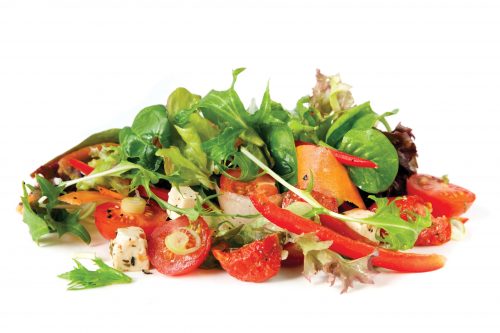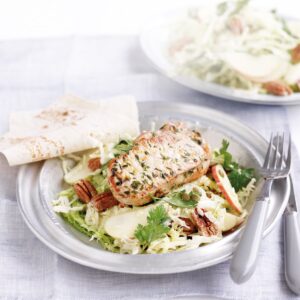
HFG senior nutritionist Rose Carr checks out salad dressings to make sure we’ve got summer salads covered.
While vinaigrette-style dressings splashed over our salad greens look ‘light’, it can be easy to underestimate how many kilojoules these dressings can be adding.
Fat and energy
Fat is not bad but it is very energy-dense. That is, a small amount of fat provides a lot of energy (kilojoules) in comparison to the same amount of carbohydrate or protein. For people trying to put on weight, generous lashings of a good vinaigrette are an easy way to add healthy fats and lots of kilojoules without making you feel over-full. For the rest of us, for whom gaining weight is much simpler and perhaps not ideal, dressings can be a trap. As always, it’s about finding the balance.
Salads like a little fat
To avoid extra kilojoules, we could be tempted to just use a splash of vinegar, such as balsamic, to dress a salad and add flavour. While that may be a valid strategy sometimes, a number of studies have shown that having some fat helps us absorb more of the nutrients from salad ingredients. A recent study found that as little as 3g fat from a dressing using an oil rich in monounsaturated fat was enough to promote good absorption of carotenoids*, which are fat-soluble. That’s the amount of fat in one tablespoon of a dressing made with one part oil to three parts vinegar, or 25 per cent fat. In this study, dressings based on saturated and polyunsaturated fats needed far higher amounts of fat to get the same benefit. So it may be a good idea to use oils high in monounsaturated fats, such as canola, olive and avocado oils, in our dressings. Of course, if you have avocado or olives in the salad, you may not need it.
*Carotenoids such as lutein, lycopene, beta-carotene and zeaxanthin are associated with reduced risk of several chronic and degenerative diseases such as cancer, cardiovascular disease and macular degeneration.
Sodium
The amount of sodium (salt) in dressings varies enormously so it pays to check the nutrition information panel. Some dressings have virtually no sodium while others can have 200mg in just a 15ml tablespoon (that’s equal to 1330mg per 100ml). If you’ve been told to lower your sodium intake, choose dressings with less than 1000mg per 100ml, lower is better. The rest of us may want to use a higher-sodium product now and then but we recommend choosing lower-sodium products for everyday use.
Sugar
While oil is traditionally the main ingredient in dressings providing flavour and texture, some low-fat products use sugar to add body and flavour. Adding a little sugar to a dressing is fine — if it means we’ll eat more salad. It’s just good to be aware of what’s in our food. In some cases, it may encourage us to limit how much we use. It’s also important we have variety in our diets and don’t confine ourselves to always choosing sweet foods.
Checklist
Use these criteria to help choose a healthier salad dressing.
- Saturated fat: 8g or less per 100ml (1.2g or less per 15ml serve)
- Sodium: 1000mg or less per 100ml (150mg or less per 15ml serve)
And for those wanting to limit energy/kilojoule intake:
- Energy: 1000kJ or less per 100ml (150kJ or less per 15ml serve)
Making vinaigrette
Traditional recipes for vinaigrette often specify three parts oil to one part vinegar, although when lemon juice is used it can be closer to equal amounts for each. We can modify the energy in our homemade vinaigrette by altering the blend to suit.
Compare the energy in one tablespoon (three teaspoons) of each of these blends:
- Three parts oil to one part vinegar — 380kJ
- One part oil to one part vinegar — 255kJ
- One part oil to three parts vinegar — 130kJ
www.healthyfood.com










